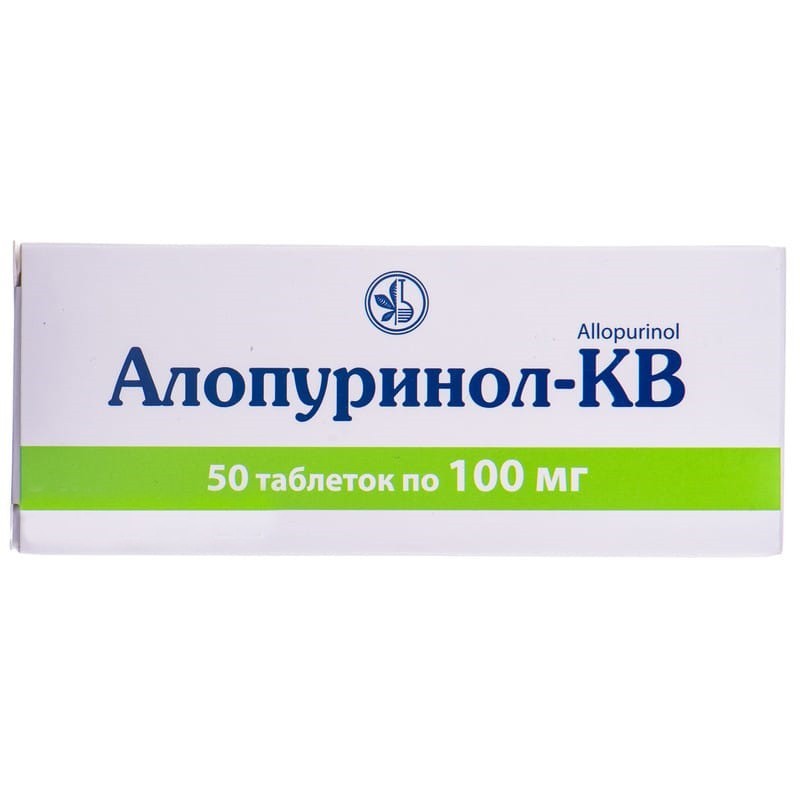



 Secure and encrypted payment processing
Secure and encrypted payment processing We ship to over 40 countries including the USA, UK, Europe, Australia and Japan
We ship to over 40 countries including the USA, UK, Europe, Australia and Japan Guaranteed refund or reship if you haven't received your order
Guaranteed refund or reship if you haven't received your orderallopurinol and its main metabolite, oxypurinol, disrupt the synthesis of uric acid, have urostatic properties, which are mainly based on the ability to suppress the enzyme xanthine oxidase, which catalyzes the oxidation of hypoxanthine to xanthine and xanthine - to uric acid, which leads to a decrease in the concentration of uric acid and helps to dissolve urates.
Pharmacokinetics Allopurinol is rapidly absorbed in the upper digestive tract. After oral administration, allopurinol is determined in blood plasma after 30-60 minutes. The bioavailability of the drug is 67–90%.
Cmax allopurinol and its metabolite oxypurinol in blood plasma are reached, respectively, after 1.5 hours and 3-5 hours after administration. Allopurinol almost does not bind to plasma proteins. Its distribution volume is approximately 1.3 l / kg body weight.
Allopurinol Fast (T½ from plasma 2–2 hours) is oxidized through xanthine oxidase and aldehyde oxidase to oxypurinol, which is also a potent inhibitor of xanthine oxidase, but T½ metabolite can last from 13 to 30 hours. Given the long T½ oxypurinol at the beginning of therapy, its gradual accumulation is possible until an equilibrium plasma concentration is reached. In patients with normal renal function, the average plasma concentration of oxypurinol is usually 5–10 mg / L after a single dose of 300 mg of allopurinol.
Allopurinol is excreted mainly by the kidneys, and less than 10% of the drug is unchanged. Approximately 20% of allopurinol is excreted in the feces. Oxypurinol is excreted unchanged in the urine after tubular reabsorption.
Impaired renal function leads to an increase in T½ oxypurinol, therefore, patients with renal failure should adhere to dosage recommendations.
Adults treatment for all forms of hyperuricemia not controlled by diet, with serum uric acid levels in the range of ≥535 μmol / L (9 mg / 100 ml); diseases caused by an increase in the level of uric acid in the blood serum, in particular gout, urate nephropathy and urate urolithiasis; secondary hyperuricemia of various origins; primary and secondary hyperuricemia in various hemoblastoses (acute leukemia, chronic myelogenous leukemia, lymphosarcoma).
100 mg tablets
Children and adolescents with a body weight of ≥15 kg:
300 mg tablets
Children and adolescents weighing ≥45 kg:
Adults
The daily dose is determined individually depending on the level of uric acid in the blood plasma. To reduce the risk of adverse reactions, treatment should be started with the use of 100 mg of allopurinol once a day and increase the dosage only if the level of uric acid in the blood serum is not reduced enough.
The following dosage regimens are recommended:
If the daily dose of allopurinol exceeds 300 mg, it should be divided into several doses (not more than 300 mg once).
When calculating the dose of the drug per patient’s body weight, doses of 2-10 mg / kg body weight per day should be used.
Children and adolescents weighing ≥15 kg. The daily dose of allopurinol is 10 mg / kg, divided into 3 doses. The maximum daily dose is 400 mg. Use 100 mg tablets.
Children and adolescents weighing ≥45 kg. The daily dose of allopurinol is 10 mg / kg, divided into 3 doses. The maximum daily dose is 400 mg.
Elderly patients. Due to the lack of special data on the use of allopurinol in this category of patients, it is recommended to use the drug in the lowest therapeutically reasonable doses. The possibility of impaired renal function in the elderly should be considered.
Patients with renal failure. Since allopurinol and its metabolites are excreted by the kidneys, if their function is impaired, an overdose is possible if the dose has not been properly selected.
In severe renal impairment, the maximum daily dose is 100 mg. It is possible to use a single dose of 100 mg with an interval of more than a day (every 2-3 days).
If it is necessary to increase the dose, it is necessary to control the level of oxypurinol in blood plasma, which should not exceed 15.2 μg / ml.
| Creatinine clearance, ml / min | Daily dose |
| 20 | Standard dose |
| 10–20 | 100-200 mg |
| 10 | 100 mg or 100 mg every 2-3 days |
For hemodialysis, after each session (2-3 times a week), apply 300-400 mg of allopurinol.
Patients with impaired liver function. Patients with impaired liver function should be prescribed the drug in lower doses. At the beginning of therapy, it is recommended to periodically monitor the performance of liver function tests. 300 mg tablets should not be prescribed to these patients because of the high content of the active substance.
Tablets should be taken after a meal without chewing with a large amount of liquid.
The duration of treatment depends on the course of the underlying disease. In order to prevent the formation of oxalate and urate stones and in primary hyperuricemia and gout, in most cases, long-term therapy is necessary. In secondary hyperuricemia, short-term treatment is recommended in accordance with the duration of the increase in uric acid levels.
Hypersensitivity to allopurinol or any of the components of the drug. severe renal impairment (creatinine clearance 2 ml / min) and liver. with creatinine clearance of 20 ml / min, 300 mg tablets are not used.
At the beginning of treatment with allopurino